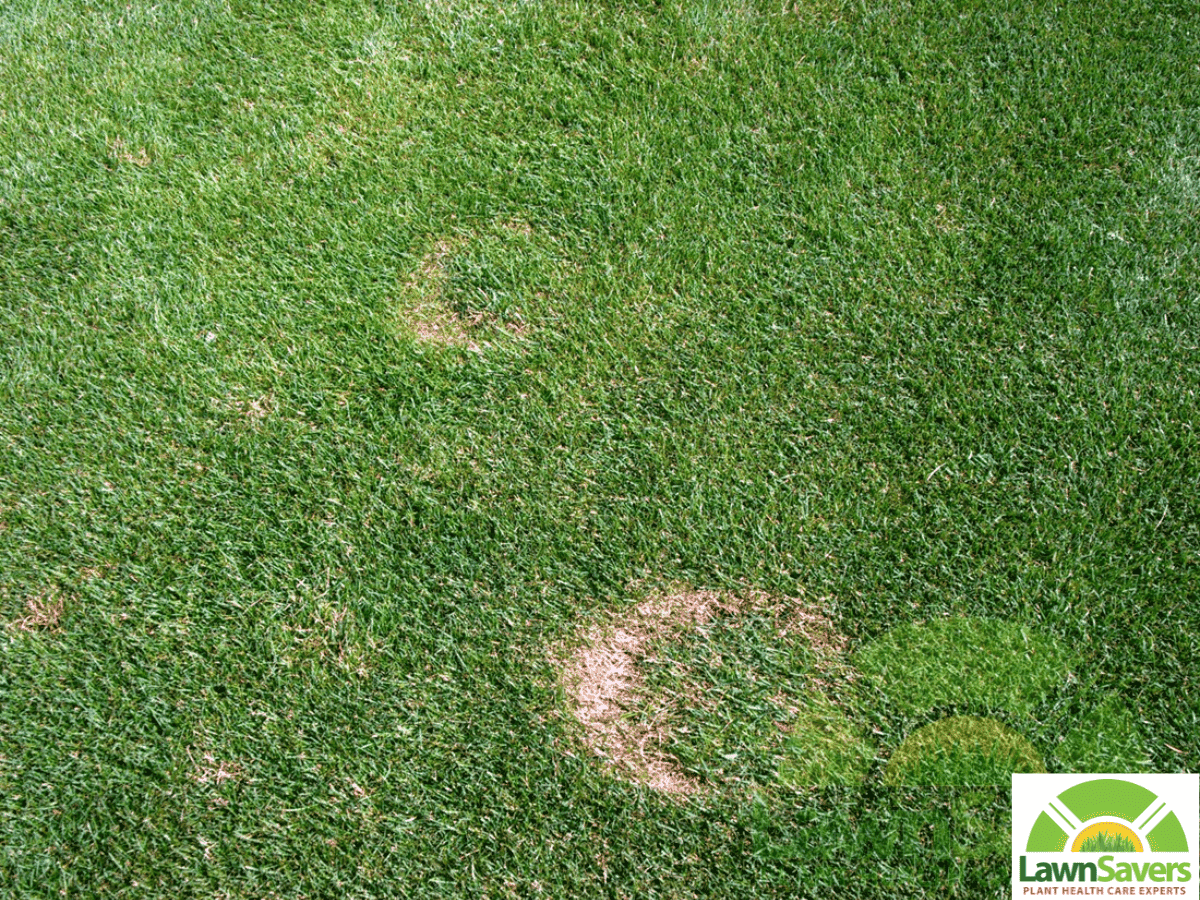TL;DR
- Cause: Necrotic Ring Spot is a fungal disease caused by Leptosphaeria korrae, primarily affecting Kentucky bluegrass.
- Symptoms: Appears as brown rings or arcs of dead grass, often with a green center, resembling “frog-eye” patterns.
- Spread: The fungus spreads through spores and mycelia, often via contaminated lawn equipment.
- Management: No chemical cure exists. Management includes aeration, overseeding with resistant grass varieties, and maintaining proper lawn care practices.
- Prevention: Preventative measures involve proper mowing, watering, and fertilization to promote strong, healthy grass.
What to do with Brown Circles on your lawn? You might have Necrotic Ring Spot!
The hot weather and frequent rain are creating ideal conditions for lawn fungus disease to thrive.
The most serious lawn fungus/disease issue we see exposed in the heat of summer is Necrotic Ring Spot. Some would often refer to it as dead circles in their lawn or brown rings in their lawn. There are many issues that affect lawns that can cause brown spots on a lawn. Some of the more common lawn issues that cause the appearance of ‘dead patches’ in your grass or in your lawn can be insects like Chinch bugs, Grubs or LeatherJackets; but also in the summer, various shallow-rooted weed grasses like bentgrass, and Poa annua (annual bluegrass) that are very common in home lawns will hibernate or die off due to stress and heat, causing brown spots.
Necrotic Ring Spot, caused by the fungus Leptosphaeria korrae, will in its advanced stage, show damage that takes the form of brown rings of dead grass. many of the rings can be incomplete, and sho as a small, slight arc, while others look like fist sized depressions of brown dead looking lawn. Necrotic Ring Spots main host is unfortunately the most common grass on home lawns, Kentucky bluegrass (which is the primary grass species that 95% of sod grown for home lawns in Southern Ontario)
At early stages, the damage we see from these ‘dead rings in the grass’ appears as scattered patches that coalesce and pull out easily. The roots and crowns have been killed, so nothing holds the grass in the soil anymore. The fungus spreads outwards in an ‘arc form’ by spores and mycelia. New grass can grow back in the region the fungus has abandoned, resulting in the characteristic ring shape. Cool wet weather promotes the fungus’s growth in spring and fall, but the dry hot summer reveals its symptomatic arcs and circles of dead grass more blatantly. Unchecked over years, the rings of dead grass can grow to over a couple feet in diameter.
There is no cure for dead circles in your lawn caused by necrotic ring spot. There is no product registered for use in Ontario or North America for that matter, which will kill the fungus or stop it from infecting grass and causing these brown rings in your lawn. You CAN make your lawn resistant with good cultural practices.
What To Do If You Have Dead Circles of Necrotic Ring Spots On Your Lawn:
- Clean your lawnmower: Mycelia tend to attach themselves to the underside of dirty lawnmowers and are carried from lawn to lawn. We most often see the brown circles of necrotic ring spots on lawns that have a mowing service.
- Sharpen your mower blade: Torn grass blades are more easily infected because they have larger surface areas to become infected by most lawn diseases.
- Fertilize with Nitrogen: LawnSavers professional fertilizer contains a high amount of slow-release nitrogen which helps the lawn grow through this disease quicker reducing the spread of dead circles in your lawn.
- Syringing: (only recommended to help reduce an identified Necrotic ring spot problem) Water very lightly during the high heat of the day, essentially to activate the fungus and expose it to the sun, therefore decreasing its life expectancy.
- Aerate: Aerating the lawn reduces compaction thereby reducing the amount of infection and amount of circles of dead grass.
- OverSeed: with the latest Certified Varietals of resistant cultivars of Kentucky Bluegrass and resistant Perennial RyeGrass and Turf-Type Tall Fescue. (LawnSavers special OverSeed blend is updatd every year and contains the latest tech in grass seed and is very resistant)
- Let it run its course!: any efforts to seed or dig it out will only be met with disappointment as new dead circles of grass appear. Disturbing the fungus helps release more spores helping the fungus spread and causing new seedlings to become infected quickly.
How to prevent the Brown Circles of Necrotic Ring Spot
Strong roots and resistant strains of grass species will both work together to help shield your lawn from this attack of dead circles in your lawn.
- Water deeply, once or twice a week only. Grass will grow roots to where the water is. Creating a deep reservoir and allowing the surface to stay drier will encourage the roots to grow long.
- Mow frequently and high, to prevent thatch build-up which can snarl root growth.
- Aerate every year to break up excess thatch and reduce soil compaction, so the roots have a better base to grow into.
- OverSeed Annually, not only to replace any grass damaged by fungus but to introduce new, stronger varietals which resist Necrotic Ting Spot more effectively.
We can provide Full Lawn OverSeeding starting at $87 + tax and Aeration starting at $88 + tax, and both services can be bundled together for BIGGER Savings.
(based on a small lawn of under 1000 sq. ft.)
Contact the company Voted Best Lawn Care Company near you in the GTA
If you’re looking for help with your lawn care or weed problems, look no further than the local lawn experts at LawnSavers. We have over 34 years of experience helping people achieve their very best and beautiful lawns. Our effective weed control treatments can help your lawn remain lush, green, and weed-free, while we offer multiple packages to suit any budget. LawnSavers currently services the GTA including Toronto up to Newmarket and Barrie and from to Milton to Whitby and all areas in between. Contact us today for your FREE Estimate.
What a client says about LawnSavers on Google
LawnSavers has developed a plan & programs for a healthy lawn, and we’ve been following their implementation with good satisfaction. We’ve been their customer for many years and our lawns look great. Sadly my neighbours on either side don’t use LawnSavers and their lawns are visually disgraceful by comparison.
Brian K.
⭐⭐⭐⭐⭐
 9.2/10 rating with over 665 reviews and over
9.2/10 rating with over 665 reviews and over
500 5 Star reviews on Google
And read more of our great lawn care services reviews on our testimonials page.








